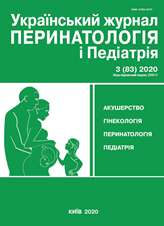Features of the clinical course of asthma combined with gastroesophageal reflux disease in children
DOI:
https://doi.org/10.15574/PP.2020.83.54Keywords:
asthma, gastroesophageal reflux disease, childrenAbstract
Among the comorbid conditions in children with asthma a significant place is occupied by lesions of the upper digestive tract+in particular, gastroesophageal reflux disease (GERD). It is known that asthma can provoke the development of reflux, and reflux in turn leads to a worsening of the course of asthma. Scientific studies indicate a better ability to control asthma in children after appropriate treatment for GERD.
Purpose — to study the features of the clinical course of asthma combined with gastroesophageal reflux disease in children.
Materials and methods. Ninety+nine children aged 6–17 years with asthma of varying severity and level of control were examined. These children which were randomly divided into two groups: group 1–79 children with asthma combined with GERD, and group 2–20 children with asthma without GERD. A questionnaire was administered, an assessment of day and night symptoms of asthma according to the scoring system was conducted, and an ACT test according to age was performed on all examined children. With the consent of the parents, twenty-two children who had complaints characteristic of gastrointestinal lesions, underwent fibroesophagogastroduodenoscopy with biopsy from the proximal and distal esophageal mucosa.
Results. In children with asthma combined with GERD, atopic dermatitis is probably more common (in 46.8% of patients), and symptoms of hypersensitive reactions to food are registered (in 74.6% of patients). Children in group 1, in contrast to children in group 2, had a longer and more severe course of asthma and probably more frequent nocturnal symptoms of the disease, which was associated with poorer control of asthma and the need for bronchodilator therapy (8.5±0.5 inhalations per month against 4.5±0.5 inhalations per month, respectively, p<0,05). Peculiarities of GERD in children with asthma were: nonspecific complaints, catarrhal changes of the lower third of the esophagus (reflux esophagitis in 98.7%), focal hyperplasia of the basal layer of the epithelium and intraepithelial eosinophilia up to 5% (9%). Girls and boys of different ages experience significant differences in complaints from the gastrointestinal tract.
Conclusions. The presence of GERD has been shown to affect the control of asthma in children, associated with nocturnal symptoms, the need for bronchodilator therapy, more severe and prolonged course of the disease, concomitant atopic dermatitis and food hypersensitivity reactions.
The research was carried out in accordance with the principles of the Helsinki Declaration. The study protocol was approved by the Local Ethics Committee of these Institutes. The informed consent of the patient was obtained for conducting the studies.
References
Anne B Chang, John J Oppenheimer, Peter J Kahrilas, Ahmad Kantar, Bruce K Rubin, Miles Weinberger, Richard S Irwin. (2019). Chronic Cough and Gastroesophageal Reflux in Children: CHEST Guideline and Expert Panel Report. Chest. 156 (1): 131–140. Epub 2019 Apr 16. PMID: 31002783. doi: 10.1016/j.chest.2019.03.035. URL: https://journal.chestnet.org/article/S0012-3692(19)30831-1/fulltext.
Antipkin YG, Lapshyn VF, Umanets TR, Kreposniak AA etc. (2019). Asthma is associated with eosinophilic esophagitis in children: is this comorbid pathology established? Proceedings of the All-Ukrainian scientific-practical conference: Modern issues of allergology: 3. URL: https://armed.org.ua/wp-content/uploads/2019/04/Tezi-Dnipro-redaktsiya-29_03.pdf.
Bolbot YuK, Kalichevska MV. (2014). Peculiarities of asthma in children with superficial and destructive lesions of the mucous membrane of the digestive tract. Problems of clinical pediatrics. 2 (24): 21—24.
Bongiovanni A, Parisi GF, Scuderi MG, Licari A, Brambilla I, Marseglia GL, Leonardi S. (2019). Gastroesophageal Reflux and Respiratory Diseases: Does a Real Link Exist? Minerva Pediatr. 71 (6): 515-523. URL: https://www.minervamedica.it/en/journals/minerva-pediatrica/article.php?cod=R15Y2019N06A0515. https://doi.org/10.23736/S0026-4946.19.05531-2; PMid:31129955
Elizabeth J Hait, Douglas R McDonald. (2019). Impact of Gastroesophageal Reflux Disease on Mucosal Immunity and Atopic Disorders. Clinical Reviews in Allergy&Immunology. 57 (2): 213-225. URL: https://link.springer.com/article/10.1007/s12016-018-8701-4. https://doi.org/10.1007/s12016-018-8701-4; PMid:30206783
Hunt Richard, Armstrong David, Peter Katelaris, Afihene Mary et al. (2017). World Gastroenterology Organisation Global Guidelines. Global Perspective on Gastroesophageal Reflux Disease. Journal of Clinical Gastroenterology. 51 (6): 467-478. URL: https://journals.lww.com/jcge/fulltext/2017/07000/world_gastroenterology_organisation_global.5.aspx. https://doi.org/10.1097/MCG.0000000000000854; PMid:28591069
Maidannik VG, Smiyan OI. (2017). Asthma in children with gastroesophageal reflux disease. Asthma in children. Tutorial. Sumy. Sumy State University: 243. URL: https://essuir.sumdu.edu.ua/bitstream-download/123456789/51770/1/Maidannyk_bronkhialna.pdf;jsessionid=ADD13DB43C4436EE03DB60E7AC871B97.
Downloads
Published
Issue
Section
License
The policy of the Journal “Ukrainian Journal of Perinatology and Pediatrics” is compatible with the vast majority of funders' of open access and self-archiving policies. The journal provides immediate open access route being convinced that everyone – not only scientists - can benefit from research results, and publishes articles exclusively under open access distribution, with a Creative Commons Attribution-Noncommercial 4.0 international license(СС BY-NC).
Authors transfer the copyright to the Journal “MODERN PEDIATRICS. UKRAINE” when the manuscript is accepted for publication. Authors declare that this manuscript has not been published nor is under simultaneous consideration for publication elsewhere. After publication, the articles become freely available on-line to the public.
Readers have the right to use, distribute, and reproduce articles in any medium, provided the articles and the journal are properly cited.
The use of published materials for commercial purposes is strongly prohibited.

